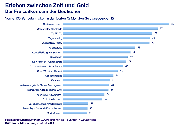Current research, 192
25 August 2006
Leisure industry: a multi-million dollar market and Germany's largest employer
BAT study on the leisure industry as
„"Leading economy of the future"“
Whether it's the World Cup or Formula 1, a festival or an amusement park, watching television at home or a holiday abroad: tourism, media, culture, sports, and entertainment have become a multi-million-dollar market, captivating millions of people. For over four decades, the leisure industry has been among the most stable growth sectors. The leisure activities on which Germans spent the most money in the last twelve months include dining out (871,000 euros), media consumption through magazines (771,000 euros), CDs/DVDs (731,000 euros), and mobile phones (711,000 euros), as well as leisure travel for day trips (711,000 euros) and holidays (591,000 euros). This is according to a recent representative survey conducted by the BAT Leisure Research Institute, in which 2,000 people aged 14 and over were asked about their consumption habits.
„The leisure industry plays a leading role in the economy. Its growth rates far exceed those of the overall economy. The leisure industry will therefore be the engine driving the economy of the 21st century,“ explains Professor Dr. Horst W. Opaschowski, the institute's academic director. He refers to the findings of the study, which is currently available in bookstores (Lit Verlag Münster) under the title „Leisure Industry: The Leading Economy of the Future.“ Together with the institute's authors and staff members, Dr. Ulrich Reinhardt and Dr. Michael Pries, Opaschowski demonstrates that the leisure industry is Germany's largest employer. Well over six million people are employed in the various leisure sectors.
The authors at the BAT Institute attribute the success of the growing leisure industry to people's increasing desire for quality of life and a better existence. A concept of leisure focused on mobility and activity, sociability and enjoyment of life makes consumption appear as part of an experience economy geared towards enhancement. This experience-oriented leisure consumption is perceived as a costly contrast to everyday life within one's own four walls.
Time and money:
The success factors of leisure consumption
Leisure activities always involve both time and money. Those with less money invest more time, while those with little time spend more money on it. Depending on income, social class, or age group, the leisure market allows for a wide range of individualizations. The authors Opaschowski, Pries, and Reinhardt demonstrate this through representative surveys.
- Young people aged 18 to 24 are most frequently represented in fitness clubs and at pop concerts.
- Singles spend the most money on sportswear and computer accessories.
- Childless couples are overrepresented on weekend trips and short breaks.
- Families with children take an above-average number of day trips and are among the most frequent visitors to theme parks.
- Young seniors aged 50 to 64, as high-spending "best agers," take the most vacation trips.
- And retirees are the most represented group among opera, concert and theatregoers.
One in six employees in Germany works in the leisure sector, and this number is rising. The leisure industry is becoming increasingly attractive, especially for aspiring entrepreneurs. The sector offers future opportunities for new businesses – from event agencies to travel agencies, from art galleries to fitness centers, and from services and events in the entertainment industry. More and more people are profiting from the "leisure business." What was once an economic factor is now a growth market.
The tourism, media, and entertainment sectors, including the video game, internet, and music markets, are experiencing particularly strong growth. Tourism alone is expected to see double-digit growth rates over the next decade. For example, air travel is projected to increase by approximately 70 percent to over 250 million passengers by 2015. This is expected to create up to 80,000 additional jobs, according to forecasts by the German Travel Association (DRV).
The entertainment industry, too, is seeing a surge in the number of creative professionals, technicians, and customer service representatives working in event management. Whether it's funfairs, art exhibitions, cinema, roller coasters, or Lohengrin – the leisure industry thrives on the diversity of its offerings.
Consequently, spending and ticket prices for opera and concert performances, sporting events, and open-air cultural events are also high. Even a leisure sector like culture, which at first glance seems relatively small, generates 35 billion euros in added value, representing 1.6 percent of the gross domestic product and thus surpassing the energy sector (30 billion).
Last year, computer and video games worth more than €1.3 billion were purchased. The industry expects double-digit growth rates for 2006. As soon as new releases appear on the entertainment market, demand surges. Even a single recreational sporting event like the World Cup becomes a driving force for economic growth in Germany, boosting the job market, filling the coffers of leisure companies (sporting goods, advertising, restaurants, etc.), and bringing a boom to mobility service providers (rail, bus, and air travel). In the future, the leisure industry will be the leading sector of the economy.
Future problem:
Leisure market as a two-tier market
One in five Germans attended a musical (20%) or a rock, pop, or open-air concert (20%) last year. Leisure activities are expensive and require significant consumption. Almost everything offered after work, on weekends, or during holidays, and which is particularly enjoyable, involves spending money. As a result, young people especially feel that there are more leisure activities available than they can afford. They therefore have to prioritize: 14- to 17-year-olds currently spend the most money on mobile phones (87%), cinemas (86%), and CDs and DVDs (80%).
Opportunities for participation and involvement in leisure activities are unequally distributed. It is striking that men dominate among visitors, participants, and users of most leisure activities. Women are only somewhat more strongly represented in wellness programs (women: 491,300 – men: 361,300), adult education courses (women: 221,300 – men: 201,300), and musicals (women: 201,300 – men: 191,300). The leisure market is not only gender-specific but also economically stratified, which is why those with lower incomes are hardly represented in expensive activities (e.g., musicals).
Only about one in three households with a net income below €1,750 was able to spend money on theater, opera, or concerts within a year. In contrast, for households with a net income above €2,000, it was one in two. Similar disparities exist for cinema visits, continuing education courses, short vacations, and sports and wellness activities.
Leisure activities require both money and time. Therefore, a future outlook emerges: Consumers' time constraints will compound their financial scarcity. This could lead to a fundamental shift in competition: "time wars," in which consumers' time (and not just their money) is contested, will shape the economy and commerce in the 21st century.
The book
OPASCHOWSKI/PRIES/REINHARDT:
Leisure industry.
The leading economy of the future
328 pages/101 graphics, available now in bookstores:
ISBN 3-8258-9297 LIT Verlag Münster 2006 29.90 Euro



